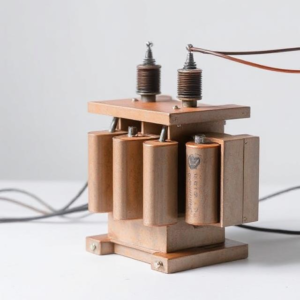1. What is a Coil?
A coil is simply a wire wound into loops or turns. Coils are used in many electrical and electronic devices to create magnetic fields when electric current flows through them. The most common type of coil is called an inductor, which stores energy in the magnetic field when electricity passes through it.

2. What is a Transformer?
A transformer is an electrical device that changes the voltage of an alternating current (AC). It works by using two or more coils that are magnetically linked. A transformer is used to either increase (step up) or decrease (step down) the voltage in a circuit, depending on the needs of the system.
3. Basic Components of a Transformer
A transformer has three main parts:
- Primary Coil: This is the coil where the input voltage is applied. It’s connected to the power source.
- Secondary Coil: This is the coil that receives the magnetic energy and provides the output voltage to the load (e.g., a device needing power).
- Core: The core is usually made of a magnetic material (like iron) and helps direct the magnetic field between the primary and secondary coils.
4. How Do Coils and Transformers Work?
Let’s start with a coil:
- When current flows through a coil, it creates a magnetic field around the wire. This is how coils work in things like motors and inductors.
- The strength of the magnetic field depends on factors like the number of turns in the coil, the amount of current, and the material of the core.
In a transformer:
- AC voltage applied to the primary coil creates a magnetic field in the core. This magnetic field induces a voltage in the secondary coil (because of a process called electromagnetic induction).
- The amount of voltage induced in the secondary coil depends on the ratio of turns between the primary and secondary coils. This is known as the turns ratio.
Key Formula:
For a transformer, the voltage ratio between the primary and secondary coils is related to the number of turns:
Where:
is voltage,
is the number of turns in the coil.
This means that if you have more turns on the secondary coil than on the primary, the transformer will increase the voltage (step up). If the secondary coil has fewer turns, it will decrease the voltage (step down).
5. Coil Design
Designing a coil involves several important factors:
- Number of turns: The more turns of wire in a coil, the stronger the magnetic field it creates. However, too many turns can make the coil bulky or difficult to manufacture.
- Wire size: The thickness of the wire affects the amount of current the coil can handle. Thicker wire can carry more current without overheating.
- Core material: The material in the core (usually iron or ferrite) helps concentrate the magnetic field. A good core material has high magnetic permeability (which means it conducts the magnetic field well).
- Coil shape: Coils can be wound in different shapes, such as cylindrical or flat, depending on the application.
6. Transformer Design
Designing a transformer involves careful planning of the following factors:
a. Turns Ratio
- The turns ratio determines the voltage change between the primary and secondary coils. If the primary coil has more turns than the secondary coil, the voltage will decrease (step-down transformer), and vice versa for a step-up transformer.
b. Core Material and Size
- The core material needs to have good magnetic properties, typically made of laminated iron to reduce energy loss from heat.
- The size of the core is important because it affects the transformer’s efficiency. A larger core can handle more power, but it also takes up more space and is more expensive.
c. Frequency
- Transformers work with alternating current (AC). The frequency of the AC affects how well the transformer works. For example, a transformer designed for power plants (which operate at 50 Hz or 60 Hz) might not work well with high-frequency signals.
d. Efficiency and Losses
- Transformers aren’t perfect; they have losses. The two main losses are:
- Core loss: Occurs due to the material of the core and the changing magnetic field.
- Copper loss: Occurs due to resistance in the wires of the coils.
- Efficient design minimizes these losses.
e. Voltage and Current Ratings
- The transformer must be designed to handle specific voltage and current levels without overheating or becoming damaged. This is based on the turns ratio and the wire gauge (thickness).
7. Practical Example of Transformer Use
Let’s say you’re designing a transformer for a wall charger:
- The primary coil would be connected to the 120V power outlet.
- The secondary coil would provide the necessary voltage (for example, 5V) to charge a smartphone.
- The number of turns on each coil is carefully chosen to achieve the correct voltage transformation based on the turns ratio.
8. Coil and Transformer Applications
- Coils are used in:
- Motors: To create magnetic fields that drive the motor.
- Inductors: To filter signals or store energy.
- Electromagnetic devices: Like relays and solenoids.
- Transformers are used in:
- Power transmission: To step up the voltage for long-distance transmission and step it down for use in homes.
- Electronics: To provide the correct voltage for devices (like chargers, power supplies).
- Isolation: To separate parts of a system electrically, preventing interference or hazards.
Conclusion
In simple terms, coils are just wires wound into loops that create magnetic fields when current flows through them, while transformers use coils to change voltage levels in AC circuits. The design of coils and transformers involves careful decisions about wire size, number of turns, core material, and voltage requirements. Transformers are used widely in power systems and electronics to efficiently manage voltage for various applications.
Tags: AC current, AC voltage transformer, coil, coil applications, coil core material, coil design, coil shape, coil wire size, copper loss, core loss, electrical device components, electrical energy conversion, Electrical engineering basics, electrical transformer, electromagnetic devices, electromagnetic induction, electronic power supply transformer, inductor coil, inductors, isolation transformer, laminated iron core, magnetic field coil, magnetic field creation, magnetic induction, magnetic permeability, motors coil, number of turns coil, power transmission transformer, primary coil, secondary coil, step-down transformer, step-up transformer, Transformer, transformer applications, transformer core, transformer current rating, transformer design, transformer efficiency, transformer frequency, transformer power rating, transformer voltage rating, turns ratio transformer, voltage transformation, wire coil, wire winding


